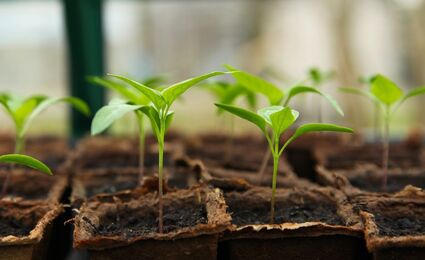Spring Garden Preparation: Seed Germination
Last updated 12/27/2022 at 8:09pm
Okay, winters here, and what a dramatic arrival! Gardeners let’s make good use of these bitterly cold weather days reviewing the litany of seed and gardening catalogues which have been piling up over the past few months. Seed catalogues are filled with detailed, useful information and reading them provides an opportunity to learn about new plant (seed) varieties available and will help you to determine if they are a good match for your gardens. Each Spring, I prefer to start most of my vegetables from seed selected from numerous seed catalogues. I personally enjoy growing several varieties of tomatoes and peppers which are not locally available for purchase. For tomato seeds, an all-time favorite seed catalogue is Totally Tomatoes. The catalogue has pepper and other vegetable seed varieties as well, but its primary focus is geared toward tomato growers. They literally have hundreds of tomato varieties from heirloom to amazing new hybrids, most of which are well suited to our SETX growing environment. Once seed selections are determined, you’ll want to place your order quickly as seed quantities are limited, and seed vendors sell out fast but also time is needed to start the germination process in preparation of spring planting.
The Farmer’s Almanac states the last frost date for SETX (Jefferson/Orange County area) is February 29th, give or take a couple weeks for surrounding cities due to our ever-changing weather patterns. My point being, if you choose to plant cold-sensitive vegetables early, be prepared to cover plants by having supplies on-hand to do so! To get an early start for spring planting, many gardeners (myself included) start seeds indoors or in a greenhouse. Germinating seeds into plants is economical since plants are always much more expensive to purchase. It’s easy to calculate when to start seeds for germination, use the anticipated last frost date and count backwards the number of weeks needed to transplant outdoors, in most cases 8 to 12 weeks.
Some types of small pots are needed for seedlings to germinate and upcycling old garden pots is always a good idea while being environmentally sensible. Remove used soil and make certain to thoroughly clean the pots using a mild bleach solution which kills germs and bacteria and air dry. Now the sterilized containers are ready to be filled with a purchased seed soil mix which is inert. It’s best to use a soil mix specifically made to start seeds, since the soil mix must be very light having the ability to hold moisture, while permitting air flow into the soil. Fill each container then tap lightly to remove air pockets. The pots are ready for seeds to be planted.
Seed packages provide detailed planting instructions with most stating to cover the seeds with at least ¼ inch of soil. Note-if following these instructions, seeds will often not germinate properly or only a few seeds will sprout. It is possible and highly likely the seeds should not be covered with soil. Many seeds need light to germinate so covering them with soil impedes germination. There are also many seeds which require darkness for germination. The amount of light or dark grossly affects their germination, as does temperature which should range between 60-70 ℉. Find a warm location, such as the top of a refrigerator or freezer, to provide bottom heat for the seeds’ container or consider purchasing a heating mat designed for seedlings. Keep the soil moist during germination, while always water containers from the bottom.
The following list is a few common vegetable and flower seeds with respective light and temperature requirements. If you are searching for a particular vegetable or flower not included below or need a more extensive list, visit the Orange County Texas Master Gardeners’ website- https://txmg.org/orange/seed-chart-veggies/
Plant
Start Seeds (Weeks to Last Frost)
Time to Germinate
(Days)
Temperature
(℉)
Light Req.
(Light/Dark)
Additional Information
Basil
6-8
7-10
60
L
cover with ¼” soil
Coleus
8
5-10
65
L
Eggplant
8
5-10
70
L or D
Four O'clock
6-8
5-10
70-85
L
cover with ¼” soil
Gaillardia
6-8
14-21
70-85
L
Gazania
4-6
8-14
68
L
surface sow-cover lightly
Parsley
6-8
14-21
65-70
D
cover with ¼” soil
Pepper
8
5-10
80
L or D
Sage
6-8
21
70
L
surface sow-cover lightly
Salvia
6-8
21
70
L
surface sow-cover lightly
Tomato
6
5-10
80
L or D
Verbena
10
15-20
65
D
Watermelon
4 or less
5-10
85
L or D
Zinnia
6
5-10
70
L or D
Plant
Start Seeds (Weeks to Last Frost)
Time to Germinate
(Days)
Temperature
(℉)
Light Req.
(Light/Dark)
Additional Information
Seeds which do not transplant well - Best when started in peat pots
Lupine
6-8
14-60
65-70
L
scar seed and soak in water, cover with ¼” soil
Dill
2-4
14
70
L
cover ¼” soil
Cucumber
4 or less
5-10
85
L or D
Nasturtium
3
10-14
70
D
cover with ¼” soil
So long for now fellow gardeners, until next year. Let’s go out and grow ourselves a greener, more sustainable world, one plant at a time! Happy New Year to each of you, be safe!
If you have specific gardening questions or would like more information, email me: [email protected] or contact the Orange County Master Gardeners Helpline: (409) 882-7010 or visit our website: https://txmg.org/orange, Facebook: Orange County Texas Master Gardeners Association or Email: [email protected].








Reader Comments(0)